The car market has been under siege from high riding menaces on all fronts. Most segments have been gutted but some have been holding out, like the performance five-door. Hot hatches are a favourite around here. They represent great bang for your buck, with usable performance relevant to real world driving. They are practical, accommodating a family’s needs and are vehicles that you can use every day. Such a car is Cupra’s new Leon VZ.
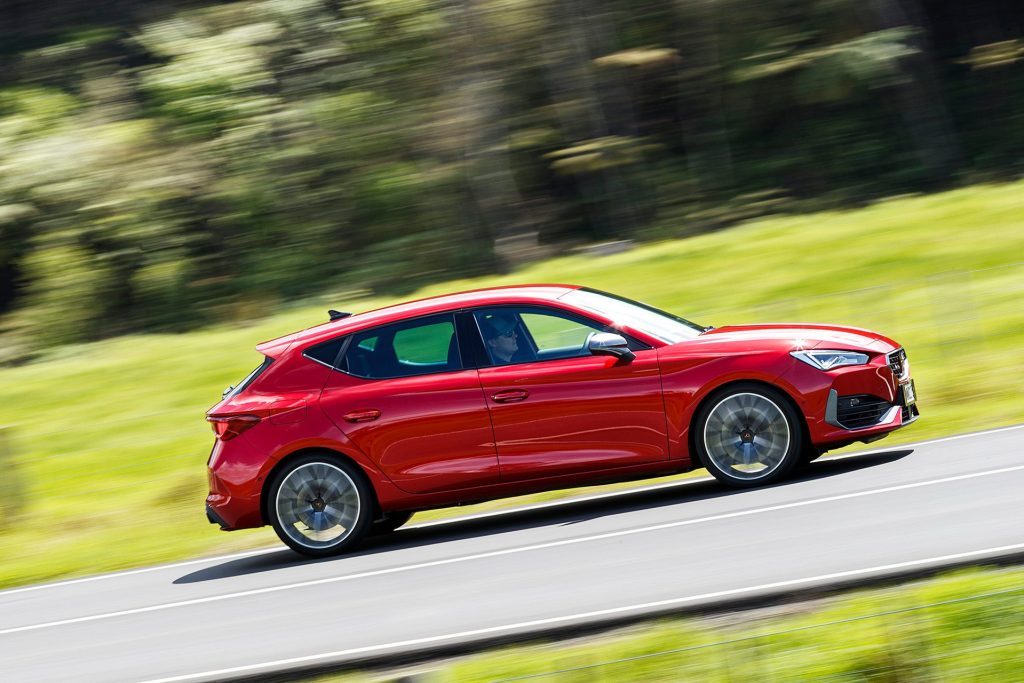
But now there are hard charging compact SUVs roaming about, the Germans leading the way with the likes of the SQ2, the X2 M and AMG’d GLA models, each eating a share of S3, M135i and AMG A-Class sales.
More market players are stepping in with small hi-po SUVs, Cupra among the first of them with its Ateca and recently the wicked Formentor VZ, while in Europe you can get the likes of T-Roc R and Puma ST. Over at Hyundai, the firm has added to its N range with the Kona, the compact SUV given the usual hot up treatment of added power, a suspension job and other hardware upgrades to make it race ready. Interestingly, it’s not all-wheel drive, but rather uses a trick front diff, much like this Cupra Leon, to ground its power. So we are here to see if the compact hot SUV really can replace the more traditional hot hatch when it comes to satisfying on all fronts. Let the games begin.
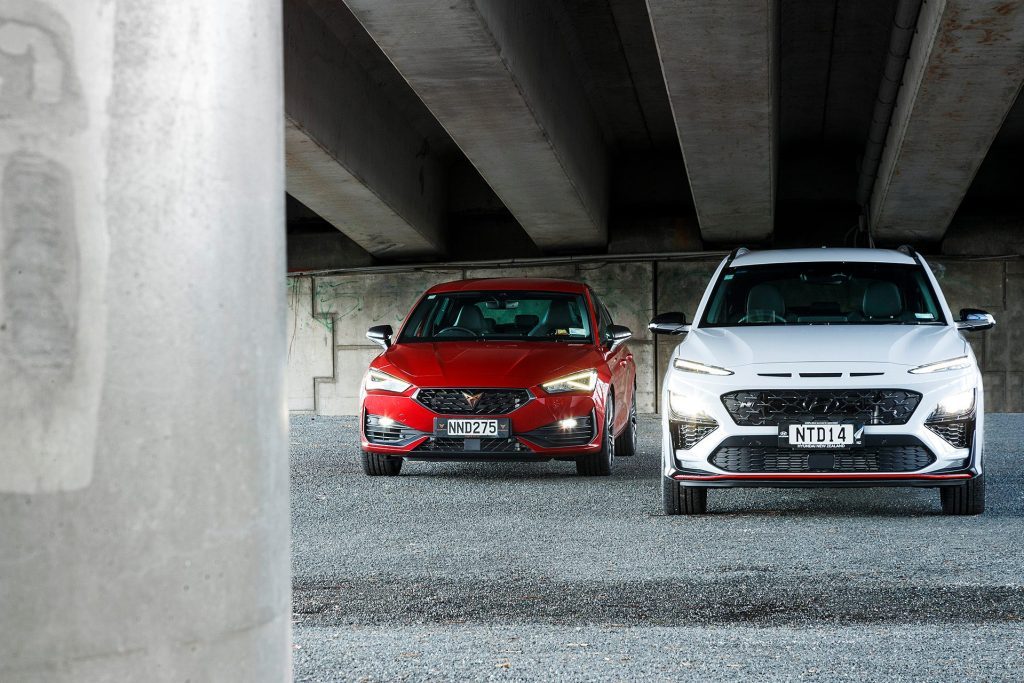
The Players
The Cupra Leon VZ is something of a performance bargain. It lists for $59,990, a few grand cheaper than the VW GTI, which is not as powerful or quick. And yet the Cupra has a very similar list of items on the spec sheet. For reference the Cupra Formentor VZ is $68,990, commanding the usual $5-10k premium a compact SUV carries over its equivalent hatch relative. Unlike the Formentor, the Leon VZ is a front driver, its 2.0-litre turbo outputting 221kW and 400Nm of torque. That’s handled by a seven-speed twin-clutch, while the drive is sorted by an eLSD.
That’s similar to what the Kona N employs. You might be surprised to learn this performance SUV is a front driver. We suspect Hyundai wasn’t keen on developing the Kona’s AWD set-up for duty in an N model, with the polished i30 N running gear dropping right in. This saves money and weight versus an AWD scenario. That said, the Kona N is still $4k more than the i30 at $69,990, thanks to the compact SUV tax.
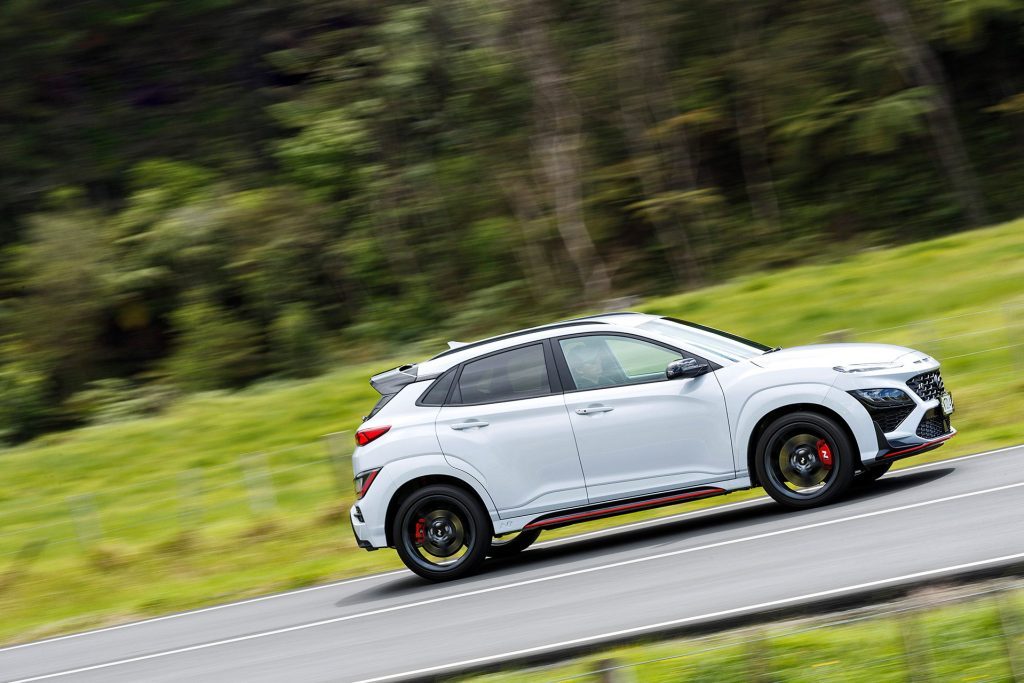
Both the Leon and Kona utilise a form of eLSD, one where electrically-controlled, hydraulically-activated clutch packs influence the flow of torque between the wheels, rather than the mechanical gear sets of a traditional LSD. This, they say, allows for a variable rate of lock, and the computer can control where the torque goes, anticipating the need, rather than reacting to it. This it does by monitoring signals from the steering, wheel speed and yaw rates to make the calculations. It can send more of the drive torque to the outside wheel in a corner, or to the wheel not slipping, and is fully variable from 0 to 100 per cent. It also works more cohesively with brake-activated torque vectoring.
The Kona N deploys a 2.0-litre turbo like its i30 N sib, generating 206kW (213kW on overboost) and 392Nm of torque. New for Hyundai is an eight-speed twin-clutch, while similarities with the Leon include adaptive dampers and sports springs (though the N doesn’t ride any lower than the normal Kona), quick steering (with 2.1 turns between the stops), uprated stoppers, performance rubber (both on 19s with 235 cross section hoops) and enhanced aural appeal.
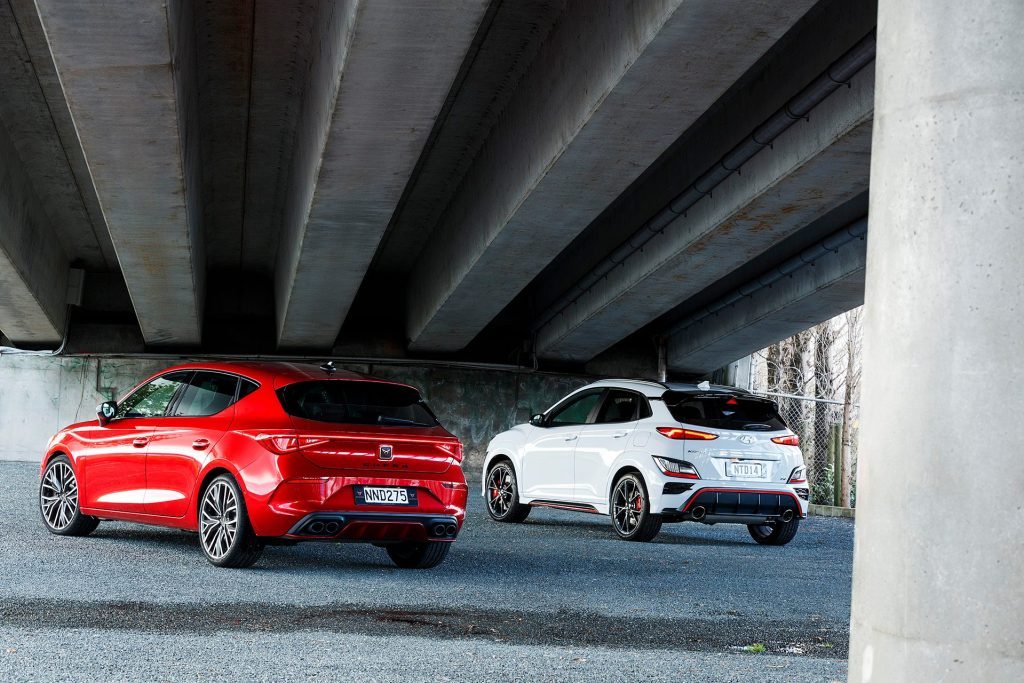
Practical?
The Leon VZ is a civil city commuter, the steering light and quick, and without the overly large turning circle that some hot hatches make you suffer. The outward vision and driving position (comfy sports seats set nice and low) are decent. Its twin-clutch and turbo gel well, the take up generally smooth. While the torque isn’t fully streaming until 2000rpm, there’s enough around the 1500rpm mark to get by on. Sometimes the trans needs a little throttle encouragement to oblige with a downshift but, if you’re in a hurry, the S transmission mode will ensure it does so more quickly.
We like the cabin with its ambient lighting (it doubles as a visual warning for things like the blind spot alert and collision warning), the build is solid, most surfaces sorted, though some of the storage areas lack linings and the centre console has a hard edge to it. The infotainment works okay once you decode its nuances; just be prepared to make multiple taps to get things working.
Rear accommodation impresses with decent leg and head room. The boot has a highload lip but the hold itself is wide and deep. There’s split folding, though it doesn’t form a flat load space.
Jumping into the Kona N, its sportier ride is immediately evident, progress is noticeably busier on both city and country roads. And there’s more road-related din as well. The new dual-clutch is a decent operator on the commute, the take up quick (at times it will slur the clutches though), works well on inclines, and picks the right gear for the occasion. It’s not afraid to pluck first when pulling away again, to ensure you’re not suffering from off-boost lethargy as the engine takes a little longer to tap its torque compared with the Leon. The Kona’s turning circle is large, the steering heavier and it wants to pull itself back to centre sooner too.
The N is a smaller machine, shorter overall in length, so there’s not the same legroom as the Leon in the rear, and its boot is smaller too. It still has the easy access of a compact SUV, and while the seats are sporty by design, they aren’t too aggressive in their bolstering. The Kona’s interior feels a little quaint next to the newer Leon, and some of the materials used aren’t up to snuff in a $70k machine.
Performance pleases
Unsurprisingly, the Leon goes a lot like the Golf GTI, but it’s more VociferouZ in nature. The Leon’s diff does well under duress, hauling hard out of bends, the drive sorted. You only get a minor inkling that the electronics are working hard when you encounter rougher bumps on the corner exit, the traction light blinking momentarily. But unruly torque steer, and axle tramp aren’t really a feature.
And the same goes for the Kona N. You can’t split them for drive off the bend, both work marvelously, at least when it’s not slick under the treads.
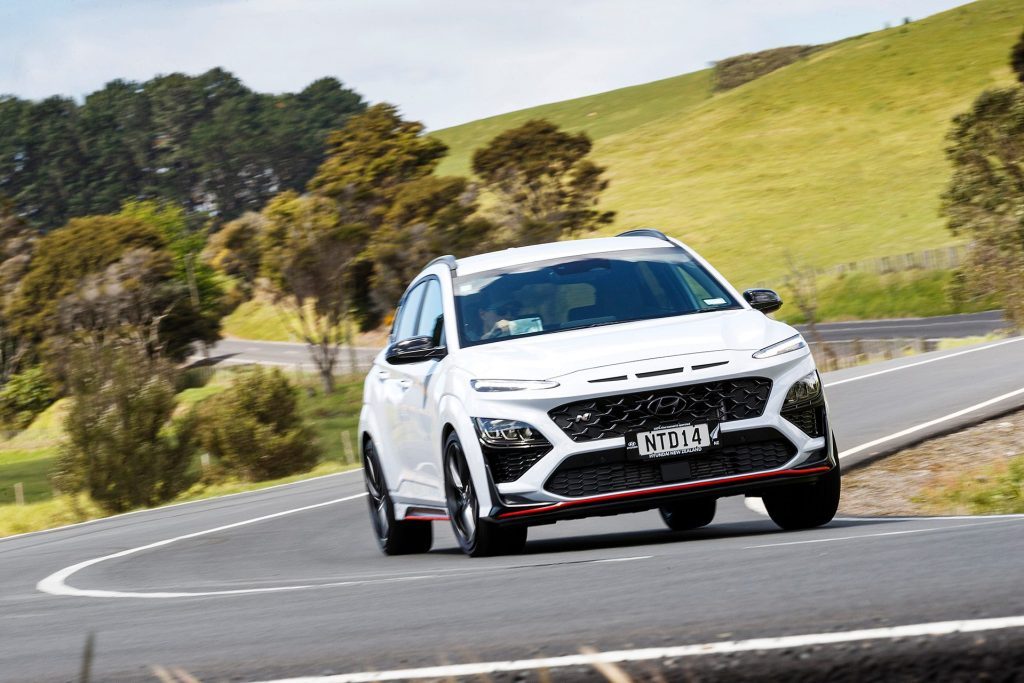
The Leon pulls strongly from 2000rpm and revs heartily to 6700rpm, the digitised noise adding character, but it could be louder, the exhaust pops certainly drowned out by the tyre roar on rougher chip sections. In its S mode, the twin-clutch aids the engine ably, the shift paddles used sparingly, if at all.
Hyundai’s 2.0-litre has a better throttle response, and it’s noisier too, in a good way. But its fuel use is more ravenous. This might have something to do with its relative freshness, the Kona with only a couple hundred kays on its odo, but it had no trouble spiking up into the high teens when lashed. And an average in the 12L/100km range seems likely long term. The Leon’s average over 3000km was sitting on 10L/100km. Our’s got to a worst of 12.6, settling down to under nine.
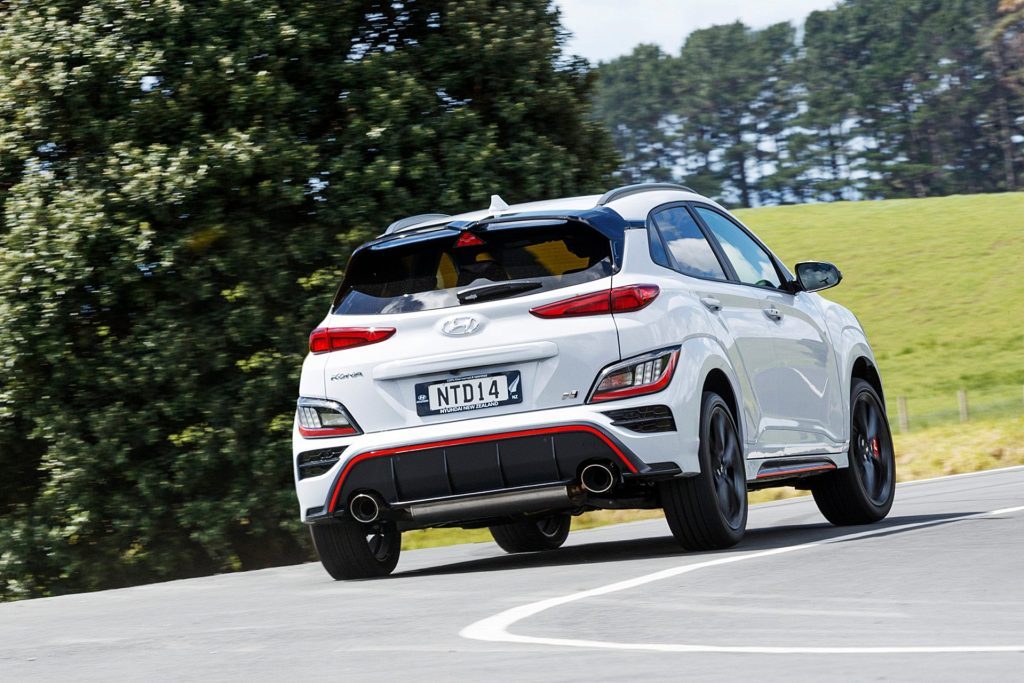
The Leon is faster out of the blocks, it’s launch control better sorted and easier to use, returning repeated 5.7sec runs, as claimed. The Kona N managed a couple of 5.8sec runs, it’s claim being 5.5sec, but struggled on the less than perfect surface.
Keep the throttle pinned and the trans performs its ‘N Power Shift’, ramming the changes through with more of a snap. It’s a swift swapper, though doesn’t always drop the cogs sufficiently when you’re on the brakes heading into a bend, requiring you to click down a ratio on the paddles.
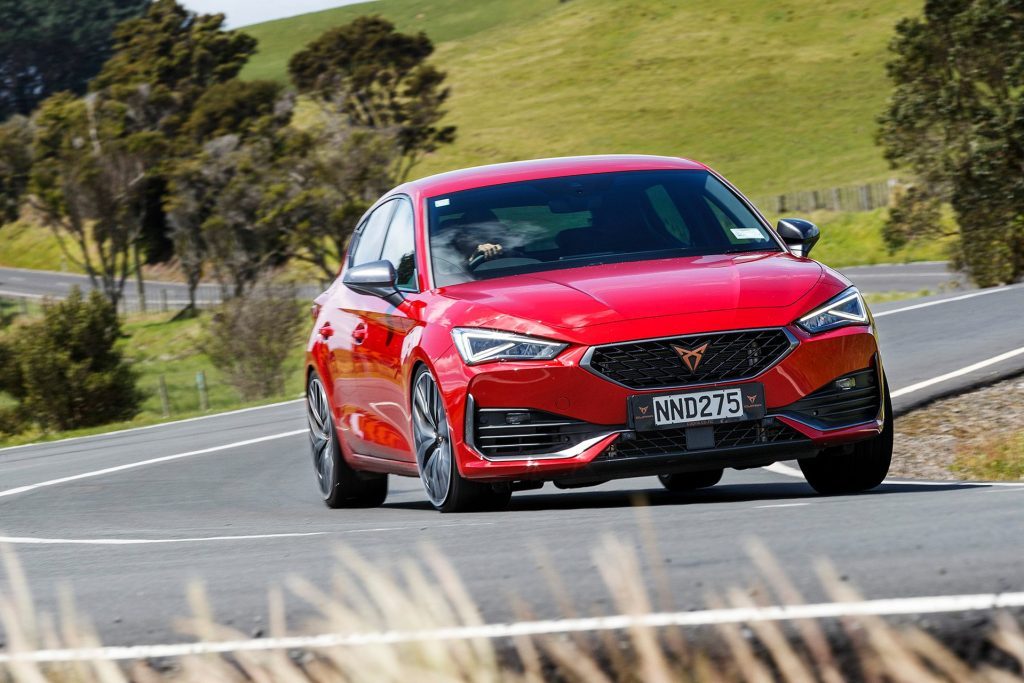
The Kona has easily selectable drive modes via it’s steering wheel-mounted buttons, whereas you need to poke away at the screen in the Leon to bring up the drive menu and then swap between Sport and Cupra. Or like we did select Individual and dial in Sport for the dampers (too crashy in max mode) and Cupra for everything else. The Kona’s N mode is all too much for the road; it too is better in Sport. It’s still a tad stiff, though the damping is competent when it encounters bumpy curves.
It’s hard to pick a decisive winner in a cornering duel, both able to hold the same velocity in the bend used for photography. The small difference being the Cupra turning in and settling that bit quicker than the Kona but really there’s nothing in it. Both have their weight well controlled and, with quick steering, they sniff out a line through the bends swiftly, understeer fended off with a good balance, decent rubber and some imperceptible brake intervention.
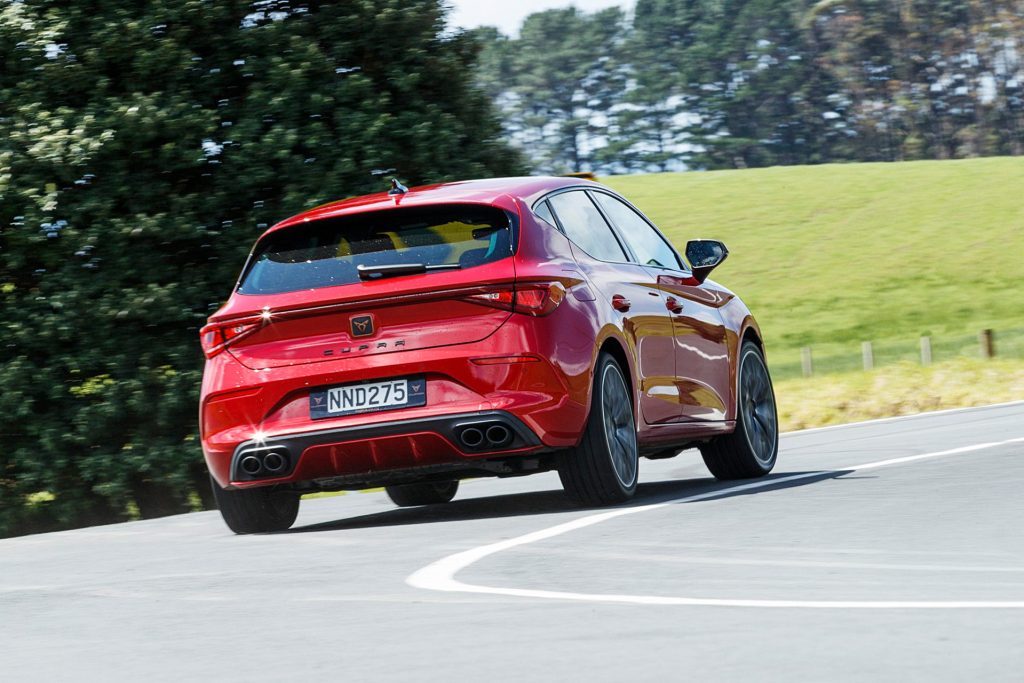
The Leon’s steering interaction is decent, if a little too refined. There’s more happening at the helm of the Kona, the messaging more dynamic. The Kona N is a decent steer, perhaps with more interaction for the driver, via its more talkative tiller and a livelier rear end set up. The Leon VZ is a rarity in that it can be driven quickly without being taxing, but it can also engage if you want to give it more of a nudge, especially when selecting the ESP Sport mode.
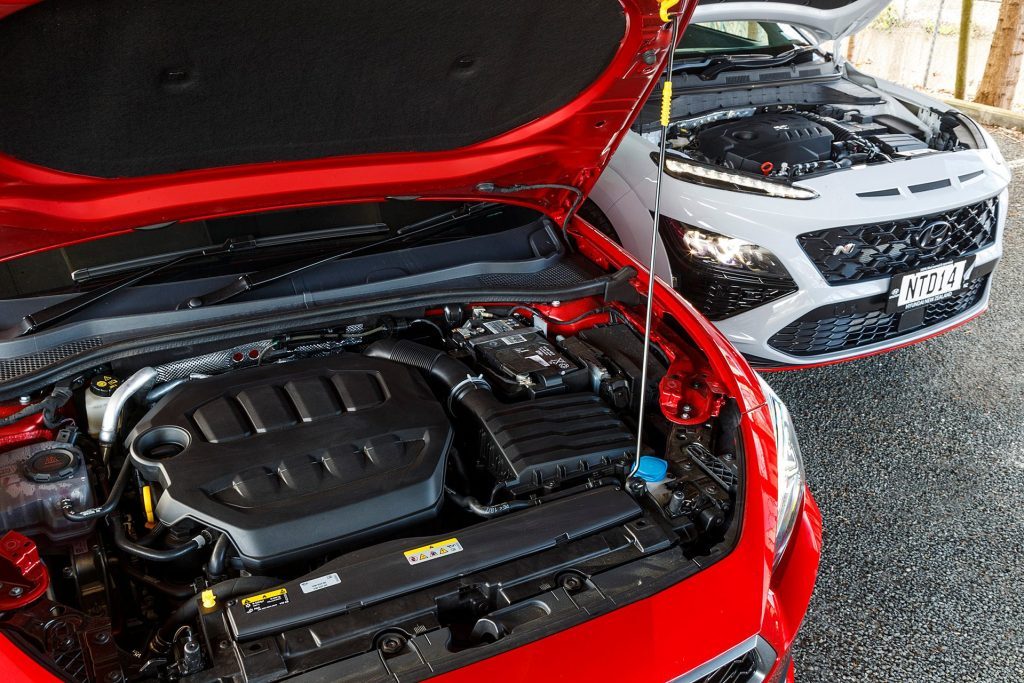
Which gets the win?
So are you selling out by opting for a performance SUV instead of a bona fide hot hatch? Not really. You don’t give up anything in a dynamic sense, but it costs more. And the Kona’s ride is too busy. As such, we couldn’t go past the cheaper Leon VZ, for it also offers better interior accommodations, is a bit easier to live with day to day, and is still a rewarding drive. But then we are a bit old fashioned here.
| Model | Hyundai Kona N |
| Price | $69,990 |
| Engine | 1998cc, IL4, T, DI |
| Power | 206kW/392Nm |
| Drivetrain | 8-speed twin clutch, FWD |
| Fuel Use | 9.0L/100km |
| C02 Output | 206g/km |
| 0-100km/h | 5.81sec |
| Weight | 1569kg (claimed) |
| Model | Cupra Leon VZ |
| Price | $59,990 |
| Engine | 1984cc, IL4, T, DI |
| Power | 221kW/400Nm |
| Drivetrain | 7-speed twin clutch, AWD |
| Fuel Use | 6.7L/100km |
| C02 Output | 174g/km |
| 0-100km/h | 5.71sec |
| Weight | 1490kg (claimed) |


